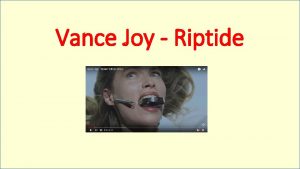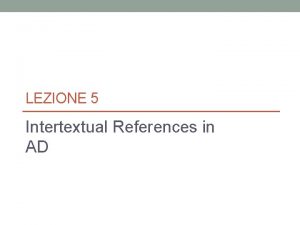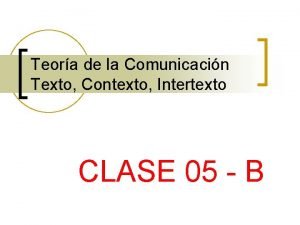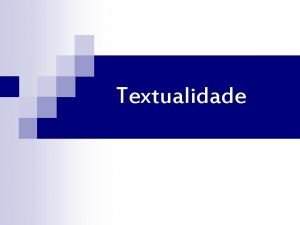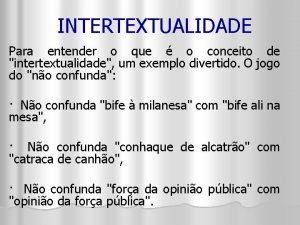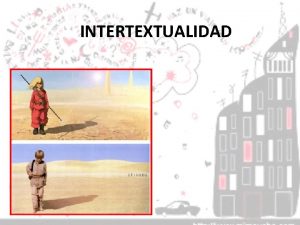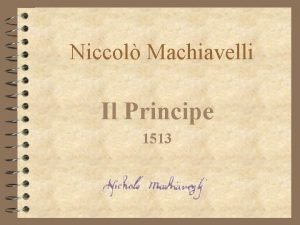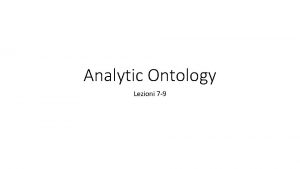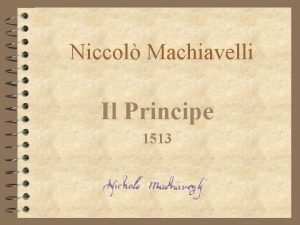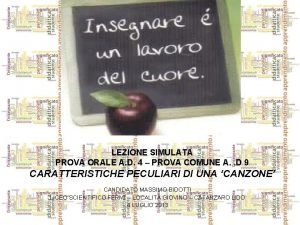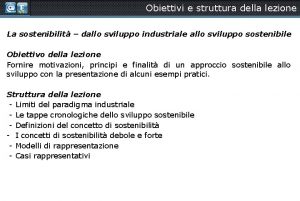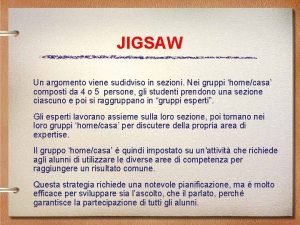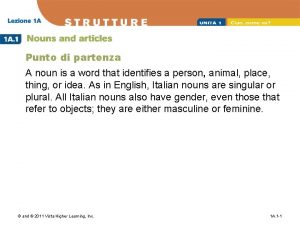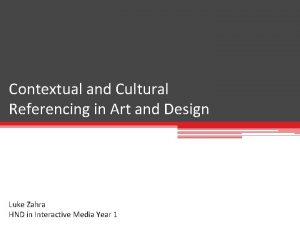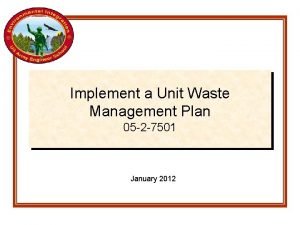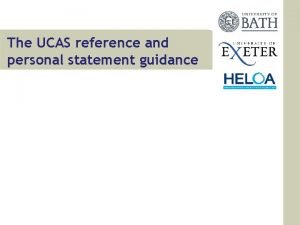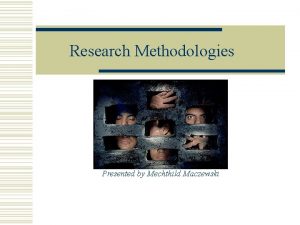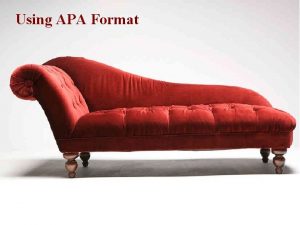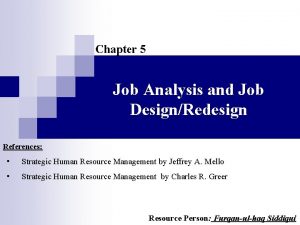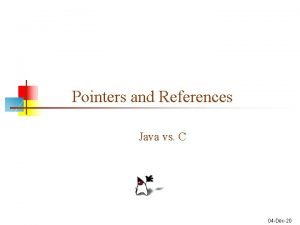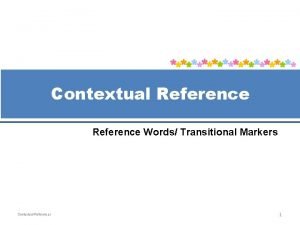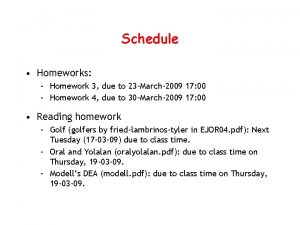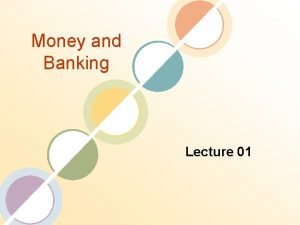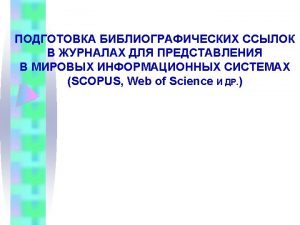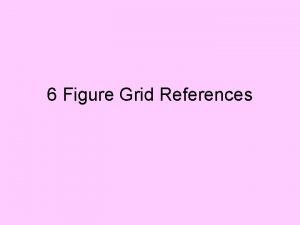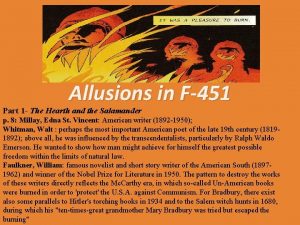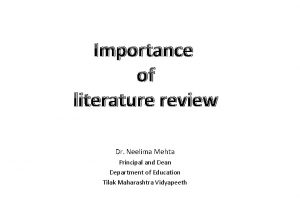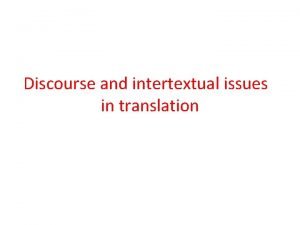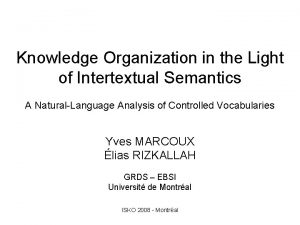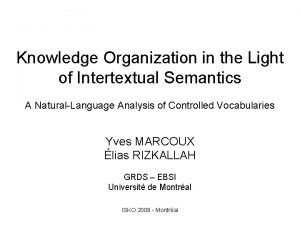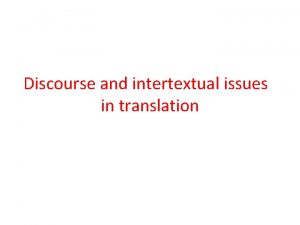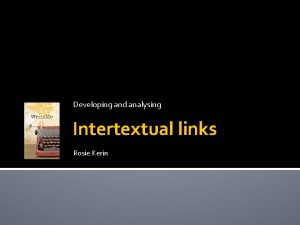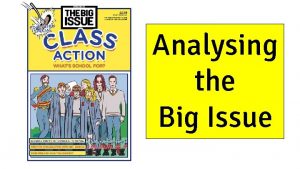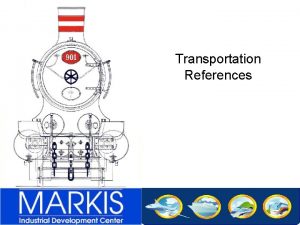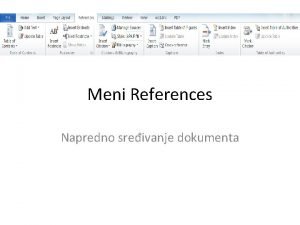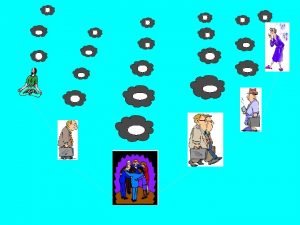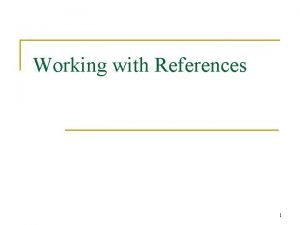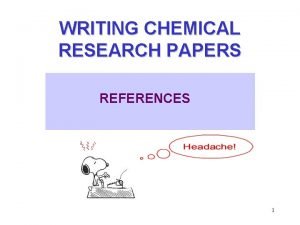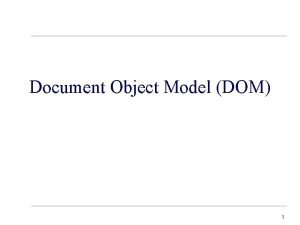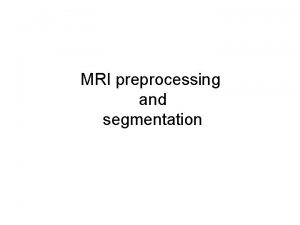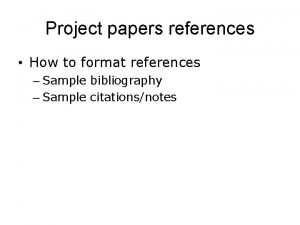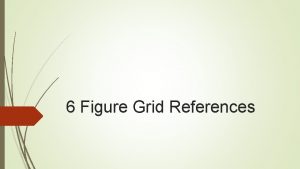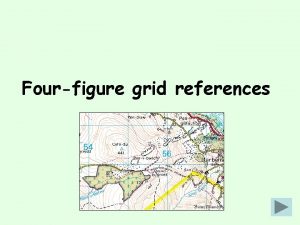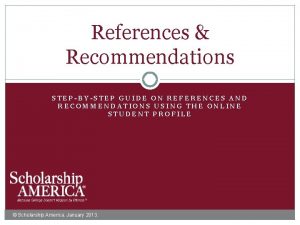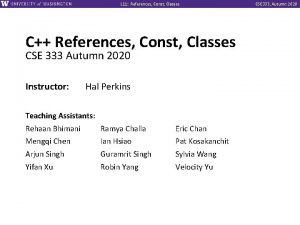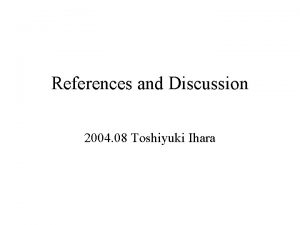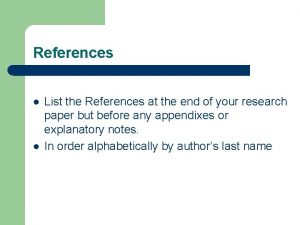LEZIONE 5 Intertextual References in AD What are





































- Slides: 37

LEZIONE 5 Intertextual References in AD

What are intertextual references? • Intertextual reference refers to the fact that practically all texts, and here a film or a television programme are regarded as ‘texts’, contain elements that can be traced to other texts. Text receivers’ understanding of one text will most often depend on their knowledge of others.

Intertextual references? • The connections may be banal, as in the case of everyday expressions, or more pregnant with meaning when created deliberately by the text producer.

Allusion • For the sighted film-goer, the intertextual references, inserted consciously or subconsciously by the text creator, will function as planned when recognized by the viewer. They are not always recognized, but noticing the reference, that is linking the alluding element with the ‘alluded to’ element, is part of the ‘intellectual’ pleasure viewers derive from the process.

For the blind … • For the blind and sight-impaired audience, these links, especially the visual links, may not be immediately accessible and thus require assistance.

Intertextual connection • So, when analyzing a source text, you need to identify examples of intertextuality and decide whether or not they need to be mentioned in the description. The following checklist of types of intertextual connection can be useful:

Verbal referents Verbal reference may be to another film, to a film genre, or to some other outside source (a book, a historical fact, etc. ). As no sensorial deficit is involved, the blind audience may well recognize such referents. For example, verbal intertextuality with reference to another film can be seen in the famous line “The name is Bond, James Bond” which appears in all the 007 books and films.

Famous sayings • An example of verbal intertextuality involving famous sayings appears in Colonel Landa’s comment to Aldo Raines in Tarantino’s Inglourious Basterds “Lt. Raines, I presume. ” Again, this is a well-known line with which the audience are presumably familiar.

Literary links Where verbal reference may not be clear, it is equally possible that it is not clear to a sighted audience either. For instance verbal intertextuality linking literary texts to films can be seen in the title of the Coen Brothers’ film No Country for Old Men which comes from a poem by W. B. Yeats (Sailing for Byzantium) bemoaning the desperation of old age.

Musical allusions Some musical accompaniments re-occur in a series of films, eg. , the James Bond theme, and do not present problems. But the connection may be between two films of different type and separated in time. In these cases a mention of the allusion may be beneficial. Tarantino’s Inglourious Basterds begins with the tune The Green Leaves of Summer which was, famously, theme music to the 1960 classic The Alamo and provides the first link that Tarantino creates with western formats.

Visual Intertextuality • The fundamental point in dealing with visual reference is to determine what the marker is and how it refers to the marked. For example visual intertextuality can be seen in parodies. In the film Love Actually, Hugh Grant is clearly meant to represent Tony Blair as his car pulls up outside No. 10 Downing Street and his clothes and mannerisms ape the erstwhile Prime Minister.

Irony or spoof • Where there is irony or spoof the description can easily include the visible manifestations – ‘a mysterious-looking castle looms out of the darkness’ in Young Frankenstein. ‘A man dressed exactly like a Bond villain’ in Austin Powers.

Copying scenes • Non-verbal intertextuality in copying scenes from previous movies is quite common. For example, in the cartoon series The Simpsons the aeroplane scene from Hitchcock’s North by Northwest is re-evoked in animated form.



Real life scenarios • Non-verbal intertextuality referring to real life scenarios is also common. Films set in eastern countries often contain scenes of busy bazaar life, crime films often begin with overviews of New York or other big city.

Visual/verbal referents • Intertextuality involving both verbal and visual referents can again be identified in many film products.

Genre • Verbal intertextuality with reference to a genre links whole series of films. For example the language used in westerns has become a recognizable language variety and needs no explanations. But the language of westerns may appear in other contexts such as satires or parodies. In an episode of the comedy series Friends, Chandler finds his pal Joey dressed in a cowboy outfit, and greets him with ‘Howdy’, harking back to hundreds of classic westerns.

Genre and repetition • Particular sequences are often repeated, for example, in TV series of a similar genre. American crime programmes invariably begin with the main actors being shown individually, and then together, accompanied by a striking musical background.

Target Text Creation • Having analysed and identified significant elements of intertextuality in a film text, first determine whether an intertextual link is crucial to the understanding or enjoyment of the film and, if so, at least identify the marker. Then decide whether making an explicit link between the marker and the marked can be helpful. Limited research indicates that AD tends to explicate the marker in order to enhance its recognisability rather than to make the link explicit unless the film or scene become incomprehensible without it.

• In cases of verbal intertextuality, the screenplay writer, director and even the actors will have consciously or subconsciously included references that will mostly be appreciated by both sighted and non-sighted audiences, such as the famous James Bond line shaken not stirred which appeared in all the books and films.

More obscure citings • But with more obscure citings, determine whether explicating this adds some useful extra information. For example those who recognize the quote ‘no country for old men’ in the film of the same name can be satisfied at recognising it, but those who don’t (the majority) may be pleased to know that it comes from Yeats. There is time during the title sequence to give this information. Cf. The Grapes of Wrath, If. You will, of course, probably be giving the blind audience an edge over the sighted audience with this information, and so decide if this is justified or may result in accusations of pandering.

Verbal dexterity • In cases of verbal dexterity such as the play on words in the Italian version of Blazing Saddles (Mezzogiorno e mezzo di fuoco) determine whether this would amuse viewers as a way of explaining an otherwise impenetrable title. It is a case in which the relation between the marker and the marked is strong, but decide whether the audience is likely to have seen (or heard of) High Noon.

• In cases of visual intertextuality, first determine whether the allusion is retrievable from the verbal input. If not, determine whether an enhanced description is required to identify the visual as a marker, and whether it is important to point out the relation with the element ‘alluded to’. In the case of Hugh Grant/Tony Blair in Love Actually determine whether the description of appearance and clothing is sufficient to make the link to the politician or add something along the lines of …evidently based on Tony Blair.

Link between films • Where there is a link between films, determine first whether the audience are likely to have seen the original ‘referred to’ item, e. g. , the aeroplane scene in North by Northwest or at least are familiar with it. Then decide whether it serves any purpose to inform the audience.

Real life relation • Where the relation is between a marked referent in real life, determine whether the marker, (e. g. , an eastern souk, a city skyline) is sufficiently recognizable as to require a mere signpost (the Istanbul bazaar, the Chicago skyline) or needs a more detailed description.

Verbal/visual intertextuality • Determine whether sufficient information is provided by the verbal input or just by a description of the visual, or whether the relation between the two is important. In the ‘cowboy’ scene in Friends, the need to describe the appearance of the character is paramount even if other elements have to be sacrificed. You might also decide to link the visual with the verbal by describing the character and then adding so… before the ‘Howdy’.

Repetition • Where there is repetition and therefore inbuilt intertextuality as in the TV crime series, determine whether simply to describe the opening sequences or add something along the lines of as in other similar crime series, thereby creating a link between the established format/genre and the current example.

Examples - verbal intertextuality (from Inglourious Basterds) • “Lt. Raines, I presume” (leave it as it is as the audience will know the original quote) • “Lt. Raines, I presume” (describe facial expression: AD - smiling arrogantly). • “Lt. Raines, I presume” (explain the quote: AD - making obvious reference to “Dr. Livingstone, I presume”). •

Examples - non-verbal intertextuality • (from Stand Up Guys) • Al Pacino and Christopher Walken come out with their guns ready (simple description) • Al Pacino and Christopher Walken come out with their guns ready to face impossible odds (enhanced description) • Al Pacino and Christopher Walken come out with their guns ready to face impossible odds, as in the final scene from Butch Cassidy and The Sundance Kid. (description with relation between marker and marked)

Examples - verbal/visual intertextuality • (from Hitchcock) • “Unfortunately I find myself once again • bereft of all inspiration. I do hope • something comes along soon. . ” • A BIRD LANDS ON HIS ARM • • A bird lands on his arm (simple description assuming audience sees the connection with ‘The Birds’) • A bird lands on his arm, an obvious pointer to his next film (partial explanation) • A bird lands on his arm obviously alluding to his next film ‘The Birds’ (full explanation risking over assistance)

The King’s Speech

To translate or not to translate • The King’s Speech • AND • Il discorso del Re

THE KING’S SPEECH The UK Film Council awarding funds by the National Lottery. Caption: in 1925 King George V reigns over a quarter of the world’s people. He asks his second son, the Duke of York, to give the closing speech at the Empire Exhibition in Wembley, London. A large grey, oval microphone stands on a desk in an empty wood-pannelled art deco room.

IL DISCORSO DEL RE Su fondo nero a centro schermi compare una luce blu che si espande formando la scritta UK Film Council che diventa di colore bianco. 1925 Re Giorgio V regna su un quarto della popolazione mondiale. Ha chiesto al suo secondo figlio, il duca di York, di tenere il discorso di chiusura all’Empire Exhibition a Wembley, Londra. In primo piano un tecnologico microfono degli anni ’ 20 è poggiato su un tavolo nello studio della BBC Broadcasting House.

comparison The UK Film Council awarding funds by the National Lottery. Caption: in 1925 King George V reigns over a quarter of the world’s people. He asks his second son, the Duke of York, to give the closing speech at the Empire Exhibition in Wembley, London. A large grey, oval microphone stands on a desk in an empty wood-pannelled art deco room. A blue light appears on a black background in the middle of the screen and expands to form the words UK Film Council which then turns white. In 1925 King George V reigns over a quarter of the world’s people. He asks his second son, the Duke of York, to give the closing speech at the Empire Exhibition in Wembley, London. In the foreground a 1920 s technological microphone stands on a table in a studio at BBC Broadcasting House.

Analysis A blue light appears on a black background in the middle of the screen and expands to form the words UK Film Council which then turns white. (not in the original) In 1925 King George V reigns over a quarter of the world’s people. He asks his second son, the Duke of York, to give the closing speech at the Empire Exhibition in Wembley, London. (exact translation) In the foreground a 1920 s technological microphone stands on a table in a studio at BBC Broadcasting House. (different emphases)
 Riptide vance joy meaning
Riptide vance joy meaning Intertext examples
Intertext examples Insidan region jh
Insidan region jh Texto, intertexto y contexto
Texto, intertexto y contexto Exemplos de intertextualidade
Exemplos de intertextualidade Intertextualidade o que é
Intertextualidade o que é Intertextualidad general
Intertextualidad general La lezione delle antique cose
La lezione delle antique cose Lezione 7
Lezione 7 L'esperienza delle cose moderne e la lezione delle antique
L'esperienza delle cose moderne e la lezione delle antique Lezione simulata
Lezione simulata Sostenibilit
Sostenibilit Jigsaw esempio scuola primaria
Jigsaw esempio scuola primaria La lezione della farfalla libro
La lezione della farfalla libro Esempio di lezione clil diritto
Esempio di lezione clil diritto Is lezione masculine or feminine
Is lezione masculine or feminine Contextual criticism art
Contextual criticism art Water conservation references
Water conservation references Ic design references
Ic design references Waste management references
Waste management references References for artificial intelligence
References for artificial intelligence Employer recommendation letter ucas reference example
Employer recommendation letter ucas reference example References slide
References slide Hypothesis example in qualitative research
Hypothesis example in qualitative research Apa format abstract page
Apa format abstract page What is dejobbing
What is dejobbing Java pointers and references
Java pointers and references Contextual reference
Contextual reference (acv-s03) homework - addresses and references
(acv-s03) homework - addresses and references Reference of money
Reference of money Asa citation machine
Asa citation machine Chubby references
Chubby references How do you do 6 figure grid references
How do you do 6 figure grid references Literary allusions in fahrenheit 451
Literary allusions in fahrenheit 451 Ibm iseries external storage
Ibm iseries external storage Importance of review of literature in research
Importance of review of literature in research Risk management reference list
Risk management reference list Export references
Export references
